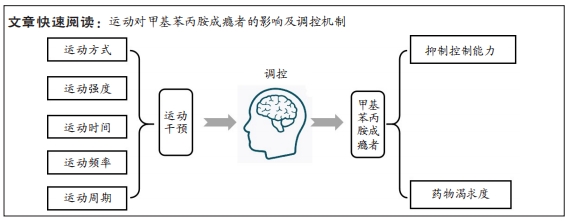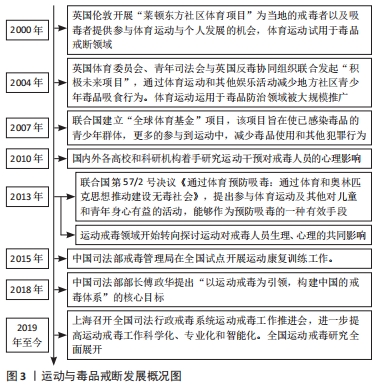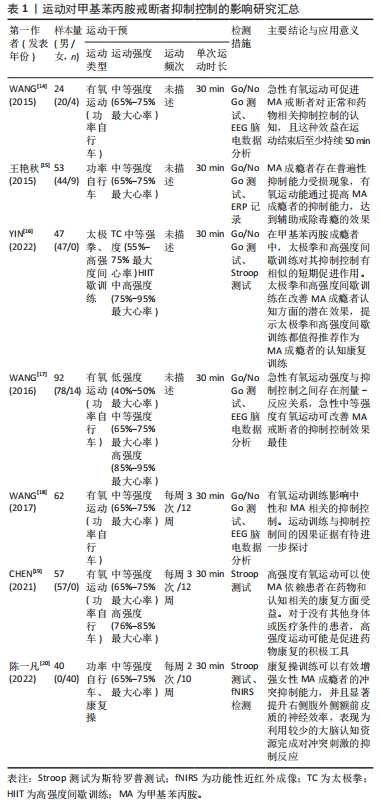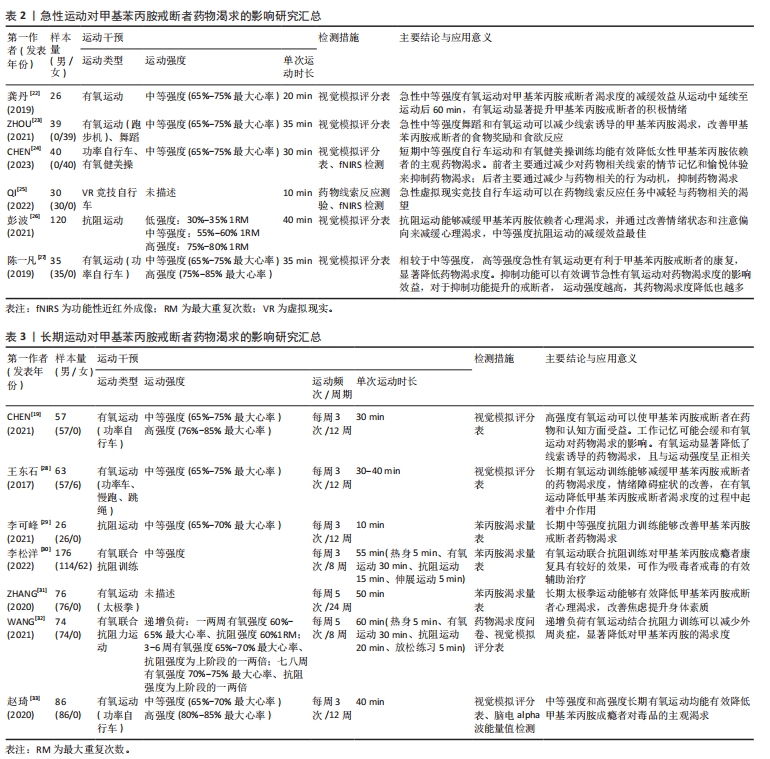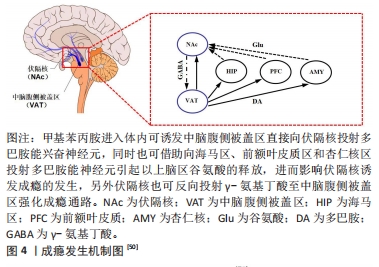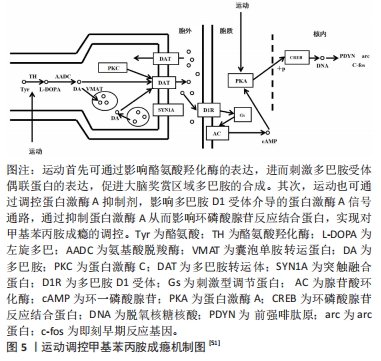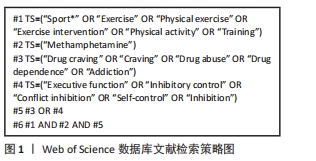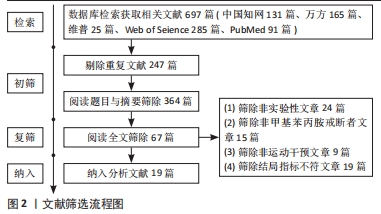[1] LAPPIN SFM. Methamphetamine use and future risk for Parkinson’s disease: evidence and clinical implications. Drug Alcohol Depen. 2018;187(6):46-63.
[2] 苏乐乐,田甜,赤艳,等.甲基苯丙胺依赖所致认知障碍的治疗进展[J].中国药物滥用防治杂志,2022,28(2):146-150.
[3] 《2019年世界毒品问题报告》:全球3500万人患有药物滥用障碍仅七分之一的人获得治疗[EB/OL]. [2023-09-06]. https://news.un.org/zh/story/2019/06/1037091.
[4] VOLKOW ND, MORALES M. The brain on drugs: from reward to addiction. Cell. 2015;162(4):712-725.
[5] 王坤,张庭然,罗炯.甲基苯丙胺成瘾者抑制控制损伤的可逆性:有氧运动的改善机制及应用研究进展[J].体育科学,2021,41(4):88-97.
[6] 杨孟,超金鹏,王德,等.运动改善注意缺陷多动障碍儿童执行功能和注意力的研究进展[J].体育科学,2022,42(5):77-87.
[7] ZHOU Y, STUBBS RJ, FINLAYSON G. A neurocognitive perspective on the relationship between exercise and reward: implications for weight management and drug addiction. Appetite. 2023;182(46):125-132.
[8] KAO S, BAUMGARTNER N, NAGY C, et al. Acute effects of aerobic exercise on conflict suppression,response inhibition,and processing efficiency underlying inhibitory control processes: an ERP and SFT study. Psychophysiology. 2022;(32):57-73.
[9] ELLINGSEN MM, CLAUSEN T, JOHANNESEN SL, et al. Effects of acute exercise on drug craving in adults with poly-substance use disorder. A randomized controlled trial. Ment Health Phys Activ. 2021;21(100423):142-157.
[10] KOHLEROVA M Z, FISEROVA Z, PAV M. Physical activity habits and their effects on quality of life in patients with addiction: data from the Czech Republic. Curr Psychol. 2023;17(6):63-81.
[11] 容浩,刘佳宁,刘旭东,等.有氧运动改善甲基苯丙胺成瘾者执行控制能力的脑机制研究[J].体育学刊,2019,26(3):138-144.
[12] 董贵俊,罗仁苹,唐泽坤,等.乒乓球运动干预甲基苯丙胺成瘾者脑激活及认知功能研究[J].中国体育科技,2021,57(6):16-22.
[13] 顾庆,盛蕾,马小铭.毒品成瘾者运动戒毒方法与康复效果研究进展[J].体育与科学,2019,40(6):37-45.
[14] WANG D, ZHOU C, CHANG Y. Acute exercise ameliorates craving and inhibitory deficits in methamphetamine: an ERP study. Physiol Behav. 2015;147(1):38-46.
[15] 王艳秋,施大庆,赵敏,等.有氧运动对改善甲基苯丙胺类成瘾者抑制能力的研究——来自ERP的证据[J].中国运动医学杂志,2015,34(3):297-302.
[16] YIN Y, YANG S, XIAO K, et al. Comparison of the acute effects of Tai chi versus high-intensity interval training on inhibitory control in individuals with substance use disorder. Front Psychol. 2022;13(941719):142-158.
[17] WANG D, ZHOU C, ZHAO M, et al. Dose-response relationships between exercise intensity, cravings, and inhibitory control in methamphetamine dependence: an ERPs study. Drug Alcohol Depen. 2016;161(4):331-339.
[18] WANG D, ZHU T, ZHOU C, et al. Aerobic exercise training ameliorates craving and inhibitory control in methamphetamine dependencies: a randomized controlled trial and event-related potential study. Psychol Sport Exerc. 2017;30(3):82-90.
[19] CHEN Y, LIU T, ZHOU C. Effects of 12-week aerobic exercise on cue-induced drug craving in methamphetamine-dependent patients and the moderation effect of working memory. Ment Health Phys Activ. 2021;21(100420):253-265.
[20] 陈一凡,蒋丰,王姁如,等.不同运动方式对女性甲基苯丙胺成瘾者冲突抑制能力的影响:一项近红外功能成像研究[J].中国运动医学杂志,2022,41(12):933-940.
[21] MORPHETT K, CARTER A, HALL W, et al. Framing tobacco dependence as a “brain disease”: implications for policy and practice. Nicotine Tob Res. 2017;19(7):48-62.
[22] 龚丹,覃丽平,朱婷,等.短时有氧运动对甲基苯丙胺依赖者渴求度、情绪状态及神经递质的影响[J].中国体育科技,2019,55(5):56-64.
[23] ZHOU Y, FINLAYSON G, LIU X, et al. Effects of acute dance and aerobic exercise on drug craving and food reward in women with methamphetamine dependence. Med Sci Sport Exer. 2021; 53(11):2245-2253.
[24] CHEN Y, WANG X, ZHOU C. Effects of different exercise patterns on drug craving in female methamphetamine-dependent patients: evidence from behavior and fNIRS. Ment Health Phys Activ. 2023;25(100534):175-184.
[25] QI L, TIAN Z, YUE Y, et al. Effects of acute exercise on craving and cortical hemodynamics under drug-cue exposure in MA-dependent individuals. Neurosci Lett. 2022;781(136672):46-59.
[26] 彭波,陈佳尘,苏锐,等.抗阻运动对甲基苯丙胺类毒品依赖者心理渴求及诱发因素的影响及其剂量效应[J].中国运动医学杂志,2021,40(1):46-54.
[27] 陈一凡,周宇,王家宽,等.急性有氧运动强度影响甲基苯丙胺戒断者药物渴求度的认知调节作用[J].中国药物依赖性杂志,2019,28(5):371-378.
[28] 王东石,朱婷.有氧运动对甲基苯丙胺类依赖者体适能、渴求度及情绪状态的作用[J].体育科学,2017,37(7):50-59.
[29] 李可峰,闫前,丁荔洁,等.中等强度抗阻训练对甲基苯丙胺成瘾者脑功能连接的影响[J].体育科学,2021,41(3):25-33.
[30] 李松洋.有氧运动联合抗阻训练对甲基苯丙胺成瘾者身心康复影响的研究[J].中国药物依赖性杂志,2022,31(3):188-193.
[31] ZHANG Z, ZHU D. Effect of taijiquan exercise on rehabilitation of male amphetamine-type addicts. Evid-based Compl Alt. 2020;2020(5):214-227.
[32] WANG J, LU C, ZHENG L, et al. Peripheral inflammatory biomarkers of methamphetamine withdrawal patients based on the neuro-inflammation hypothesis: the possible improvement effect of exercise. Front Psychiatry. 2021;12(795073):179-192.
[33] 赵琦,刘佳宁,陆颖之,等.长期有氧运动改善甲基苯丙胺成瘾者对毒品的渴求——来自alpha波的证据[J].中国运动医学杂志,2020,39(10):804-809.
[34] ROSEN L G, NINGLEI S, WALTER R, et al. Molecular and neuronal plasticity mechanisms in the amygdala-prefrontal cortical circuit: implications for opiate addiction memory formation. Front Neurosci-switz. 2015;9(3):63-74.
[35] KROLL SL, HULKA LM, KEXEL A, et al. Plasma endocannabinoids in cocaine dependence and their relation to cerebral metabotropic glutamate receptor 5 density. Transl Psychiat. 2023;13(1):325-331.
[36] 刘溪,代振凤,蒲小平.甲基苯丙胺成瘾机制进展[J].中国新药杂志,2017,26(21):2541-2545.
[37] LIN M, SAMBO D, KHOSHBOUEI H, et al. Methamphetamine regulation of firing activity of dopamine neurons. J Neurosci. 2016;36(40):10376-10391.
[38] MINER NB, ELMORE JS, BAUMANN MH, et al. Trace amine-associated receptor 1 regulation of methamphetamine-induced neurotoxicity. Neurotoxicology. 2017;57(13):26-35.
[39] SØRENSEN G, RICKHAG M, LEO D, et al. Disruption of the PDZ domain-binding motif of the dopamine transporter uniquely alters nanoscale distribution, dopamine homeostasis, and reward motivation. J Biol Chem. 2021;297(6):101361-101374.
[40] O’DELL SJ, GALVEZ BA, BALL AJ, et al. Running wheel exercise ameliorates methamphetamine-induced damage to dopamine and serotonin terminals. Synapse. 2012;66(1):71-80.
[41] MCFADDEN LM, REBECCA C, TAMEE L, et al. Behavioral and serotonergic changes in the frontal cortex following methamphetamine self-administration. Int J Neuropsychoph. 2018(8):8-17.
[42] LOMINAC KD, QUADIR SG, BARRETT HM, et al. Prefrontal glutamate correlates of methamphetamine sensitization and preference. Eur J Neurosci. 2016;43(5):689-702.
[43] 李媛媛,李娟,杨根梦,等.甲基苯丙胺神经毒性作用及机制的研究进展[J].昆明医科大学学报,2021,42(2):5-8.
[44] PUIG S, XUE X, SALISBURY R, et al. Circadian rhythm disruptions associated with opioid use disorder in synaptic proteomes of human dorsolateral prefrontal cortex and nucleus accumbens. Mol Psychiatr. 2023;32(5):28-36.
[45] CHURCHILL L, SWANSON CJ, URBINA M, et al. Repeated cocaine alters glutamate receptor subunit levels in the nucleus accumbens and ventral tegmental area of rats that develop behavioral sensitization. J Neurochem, 1999;72(6):2397-2403.
[46] MISHRA D, PENA-BRAVO JI, LEONG KC, et al. Methamphetamine self-administration modulates glutamate neurophysiology. Brain Struct Funct. 2017;222(5):2031-2039.
[47] 李彦霖,朱莉,陈娇,等.甲基苯丙胺成瘾机制概述[J].中国药物滥用防治杂志,2023, 29(2):181-187.
[48] FARIA AC, CARMO H, CARVALHO F, et al. Drinking to death: Hyponatraemia induced by synthetic phenethylamines. Drug Alcohol Depen. 2020;212(2):108045-108051.
[49] LIANG M, ZHU L, WANG R, et al. Methamphetamine exposure in adolescent impairs memory of mice in adulthood accompanied by changes in neuroplasticity in the dorsal hippocampus. Front Cell Neurosci. 2022;16(1):892757-892765.
[50] 吕宸,傅柯荃,汪洋,等.甲基苯丙胺成瘾机制及中草药治疗[J].时珍国医国药,2019, 30(9):2226-2228.
[51] 廖帅雄.不同运动模式对甲基苯丙胺戒毒者药物戒断的效果对比及最佳运动模式的肠道菌群变化研究[D].重庆:西南大学.2020.
[52] GREENWOOD BN, FOLEY TE, LE TV, et al. Long-term voluntary wheel running is rewarding and produces plasticity in the mesolimbic reward pathway. Behav Brain Res. 2011;217(2):354-362.
[53] RETZLAFF CL, ROTHWELL PE. Characterization and mu opioid receptor sensitivity of neuropeptide Y interneurons in the mouse nucleus accumbens. Neuropharmacology. 2022; 218(3):109212-109219.
[54] CÓRDOBA-GRUESO WS, MATTEY-MORA PP, CHEN C, et al. The association between exercise and prescription opioid misuse: a scoping review. Exp Clin Psychopharm. 2023;63(7):52-65.
[55] CATALFIO AM, FETTERLY TL, NIETO AM, et al. Cocaine-induced sensitization and glutamate plasticity in the nucleus accumbens core: effects of sex. Biol Sex Differ. 2023;14(1):41-53.
[56] LEE B, LONDON ED, POLDRACK RA, et al. Striatal dopamine d2/d3 receptor availability is reduced in methamphetamine dependence and is linked to impulsivity. J Neurosci. 2009; 29(47):14734-14740.
[57] BAUER EE, BUHR TJ, REED CH, et al. Exercise-induced adaptations to the mouse striatal adenosine system. Neural Plast. 2020;2020:5859098.
[58] BALDASSARRI SR, ASCH RH, HILLMER AT, et al. Nicotine use and metabotropic glutamate receptor 5 in individuals with major depressive and posttraumatic stress disorders. Chronic Stress. 2023;7(2):1994190694.
[59] MONGI-BRAGATO B, AVALOS M P, GUZMÁN A S, et al. Endogenous enkephalin is necessary for cocaine-induced alteration in glutamate transmission within the nucleus accumbens. Eur J Neurosci. 2021;53(5):1441-1449.
[60] 柯钰婷,周文华.运动干预药物依赖的神经生物学机制研究进展[J].中国药理学与毒理学杂志,2015,29(4):599-606.
[61] REAL CC, FERREIRA AF, HERNANDES MS, et al. Exercise-induced plasticity of AMPA-type glutamate receptor subunits in the rat brain. Brain Res. 2010;13(63):63-71.
[62] HE Y, MADEO G, LIANG Y, et al. A red nucleus-VTA glutamate pathway underlies exercise reward and the therapeutic effect of exercise on cocaine use. Sci Adv. 2022;8(35):1440-1451.
[63] MARTINEZ-LOPEZ JE, MORENO-BRAVO JA, MADRIGAL MP, et al. Red nucleus and rubrospinal tract disorganization in the absence of Pou4f1. Front Neuroanat. 2015;9(6):8-17.
[64] MORRIS R, VALLESTER KK, NEWTON SS, et al. The differential contributions of the parvocellular and the magnocellular subdivisions of the red nucleus to skilled reaching in the rat. Neuroscience. 2015;295(3):48-57.
[65] KATSIDONI V, TZATZARAKIS M N, KARZI V, et al. Differential effects of chronic voluntary wheel-running on morphine induced brain stimulation reward, motor activity and striatal dopaminergic activity. Behav Brain Res. 2020;394(1):112831-112839.
|
